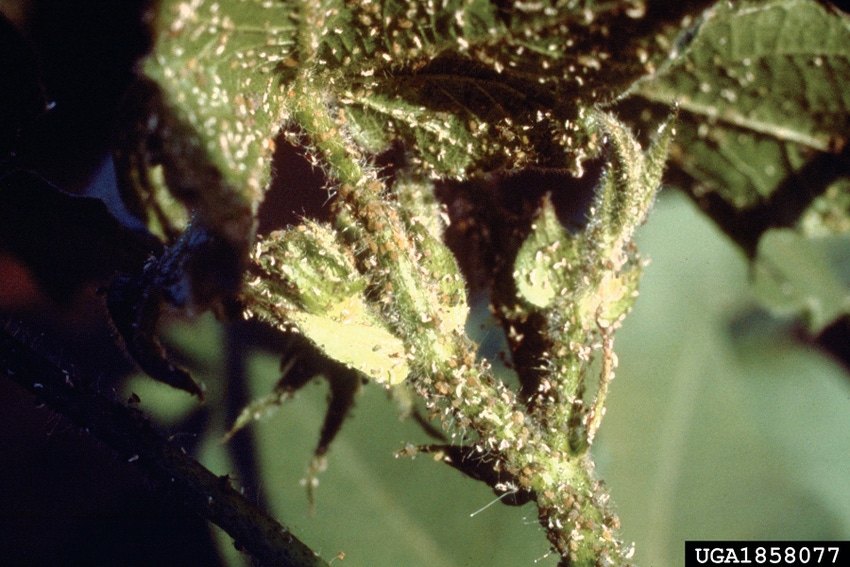October 25, 2018

A proper insecticide seed treatment can be the difference between whether early cotton seedlings can survive thrips or other insects just after planting — a time when young plants are already under pressure in typical cool, damp conditions.
Seed treatments may be even more important with the newer herbicide-resistant cotton varieties being used extensively across the Mid-South, says Scott Stewart, University of Tennessee agricultural entomologist.
“Label restrictions prevent tank mixing almost all insecticides with dicamba on XtendFlex cotton,” he says. “Those planning on growing dicamba-tolerant varieties and spraying Engenia or XtendiMax (dicamba) will be especially concerned with at-planting thrips treatments that reduce the chances of needing a foliar application.”
Unfortunately, concerns remain about the consistency of neonicotinoid seed treatments in cotton “because of resistance in populations of tobacco thrips,” he says. He recommends that growers consider the thrips control options outlined by Mississippi State University entomologists to keep plants protected during the seedling stage.
With no insecticide tank mixes allowed, MSU entomologists note, “Be sure to select a seed treatment program that can handle thrips pressure.” They point out that thiamethoxam (Cruiser) is no longer recommended on cotton in the Mid-South because of tobacco thrips resistance, but it still works for other crops when thrips are not the main target.
“In the last couple of years, we have also observed a general decrease in efficacy with imidacloprid (Gaucho),” MSU specialists say. “Although, imidacloprid is still providing some control of tobacco thrips, the likelihood of needing foliar applications is likely higher than in previous years.”
MSU lists these insecticide treatments and foliar insecticide treatments to consider in controlling thrips:
AgLogic, aldicarb: Provides very effective thrips control, and has good nematode activity. But this product is not labeled for use in all states.
Aeris, imidacloprid+thiodicarb: It “provides the best option of standalone seed treatments.”
Acceleron I, imidactoprid+acephate: Another seed treatment option, or acephate can be applied in-furrow.
Avicta Elite, thimethoxa+imidacloprid+avermectin: Another seed treatment option.
Under some circumstances, even the best seed treatments can be overwhelmed by high numbers of thrips and will require a foliar application; however, making the right choices at planting will minimize the need for foliar applications, thus saving time and money.
Although a foliar insecticide application may be necessary for thrips control on seedling cotton, Stewart says, it’s not always needed. “This is not an automatic application. Often, this decision is driven as much by weather as thrips pressure. Poor emergence conditions increase the risk of thrips injury. If the cotton blows out of the ground and looks great, with little evidence of thrips or injury by the second true leaf, then don’t make the application.”
If a foliar application is needed, it should be made before the second true leaf is fully expanded, Stewart says. “There is a lot of research showing that this is typically the best timing. There is even more data showing that two applications are rarely needed on top of at-planting treatments. Multiple applications increase the risk of flaring early season spider mites or aphids.”
Insecticide seed treatments help cotton get through the early stages of insect pressure, and are vital to an overall integrated pest management program. Seed treatments are also key parts of Mid-South corn and soybean production.
For corn, Stewart says, growers may benefit from using higher insecticide seed treatment rates or supplemental at-planting insecticide. “Higher treatment rates may be needed if you have a known soil insect problem, or if you’re planting in a field that was fallow, pasture, sod, or had a cover crop that was not terminated at least three to four weeks before planting.”
Planting corn early, during the recommended planting window, will reduce the chances of crop damage from several insect species. “For example, corn borers and fall armyworms are frequent pests of late-planted corn in Tennessee,” Stewart says.
No-till production can often increase soil insect pest problems. “Cutworms, wireworms, white grubs, seed corn maggots, and lesser cornstalk borers may build up in grass sod or where previous crop residue has been left on the soil surface at planting,” Stewart says. “Burndown with herbicides three to four weeks before planting can reduce the risks of infestation.”
Soybeans are less likely than either corn or cotton to consistently benefit from an insecticide seed treatment, he says. “But a lot of data show an average yield response of about 2 bushels per acre in the Mid-South, with a more consistent response on early planted soybeans. Growers should consider planting insecticide-treated seed in early-planted fields.”
When selecting a seed treatment for any field crop, Stewart advises growers to talk with their crop consultant, seed representative, or Extension specialists to determine which treatment may be best-suited for their environment.
Any help plants can get in heading off insect pressure will reduce stress on cotton, corn, and soybeans.
(For a full list of MSU seed treatment recommendations, visit https://bit.ly/2oVLjAV)
About the Author(s)
You May Also Like




